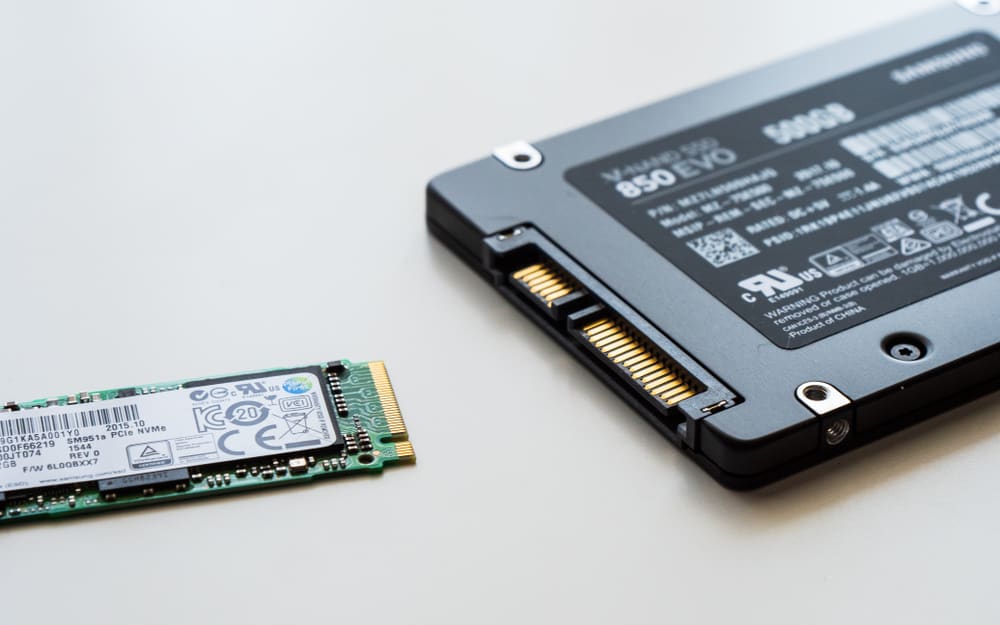Table of contents

凭借紧凑的机身和快速的速度,固态硬盘比更传统的HDD有很多优势。 但听起来可能令人惊讶的是,与HDD相比,固态硬盘在活动时消耗更多的电力。 但究竟固态硬盘消耗多少电力?
快速回答固态硬盘的耗电量取决于其类型。 对于 SATA和NVME固态硬盘 ,耗电量为 闲置时0.2-3瓦特 , 读取数据时2-8瓦特 ,以及 写入数据时3-10瓦特 .
另一方面,在 PCLe SSD 消耗 空闲时2-6瓦特 , 读取数据时3-7瓦特 ,以及 写入数据时5-15瓦特 .
在这篇文章中,我将列出不同SSD的功耗,比较SSD和HDD的功耗,并解释如何计算你的SSD的功耗。
See_also: 如何在应用程序上取消Grubhub的订单衡量不同SSD的耗电量
在我深入研究不同SSD所使用的瓦特功率的细节之前,值得注意的是,我将以范围来说明SSD的耗电量。 下限代表最小 使用的瓦特数; 上限代表最大 SSD使用的瓦特数。
我已经收集了三种状态下的固态硬盘的数据: 闲置、读取和写入 "空闲 "是指当 SSD没有处理任何数据 而 "读 "和 "写 "是当它是 读取和写入磁盘上的数据 此外,不同品牌的SSD的数据可能会有所不同。
2.5英寸SATA固态硬盘
2.5英寸SATA固态硬盘的耗电范围为 闲置时0.25-2瓦特 .当它是 阅读 消耗数据的成本很高。 4-8瓦特 更进一步说,它消耗了 写入时,5 8瓦特的数据 .
MSATA SSD
MSATA固态硬盘在耗电方面做得相当好。 当 闲置 它们的功耗可以在一个很好的、狭窄的范围内变化。 0.21-1.20瓦特 ...虽然 阅读 数据,它们消耗了一个合理的功率 2-5瓦特 .
当涉及到写入数据时,这种功率保护就消失了。 而 写作 数据,它们在一定范围内消耗功率。 5-8瓦特 .
M.2 SATA SSD
M.2 SATA固态硬盘的适度功耗范围为 闲置时0.30-2瓦特 .当 阅读 数据,它们会消耗 2-6瓦特 鉴于他们消费的是 3-9瓦特 当 写作 总的来说,它们有一个合理的耗电范围。
M.2 NVME SSD
M.2 NVME固态硬盘的功耗仅比M.2 SATA固态硬盘高一点。 它们的功耗相当高。 闲置时0.50-3瓦特 .当 阅读和写作 数据,它们会消耗 2-8瓦特 和 3-10瓦特 分别。
PCIe SSD
与SATA和NVME固态硬盘相比,PCle固态硬盘消耗的瓦数最多。 它们的消耗量非常大 空闲时2-6瓦特 , 读取数据时3-7瓦特 ,以及 写入数据时5-15瓦特 .
See_also: 如何AirDrop到电脑上消耗功率[SSD与HDD的比较]。
听说过很多关于SSD的快速性,可能会很惊讶,选 音速SSD比机械HDD消耗更多的能量 这是因为在SSD中加入了大量的电路,而这是HDD所缺乏的。
但这并没有使固态硬盘在功耗方面处于劣势。 相反,当固态硬盘处于空闲状态时(大部分时间都是如此),它们会 消耗的功率远远低于空闲的硬盘 .最终,与HDD相比,这使得电源变得保守了。
如何计算你的SSD的耗电量
如果你想知道你的固态硬盘的确切耗电量,你可以查询你的 SSD的规格表 如果你找不到你的SSD的实际功耗,你仍然可以计算出来。
找出 你的SSD的电流和电压 你得到的数字就是SSD的功率。
更高的功耗对SSD来说是坏事吗?
如果你的固态硬盘的功耗大于平均水平,那就没什么好担心的了。 它 不会影响你的SSD的性能 它只会 缩短电池的使用寿命 少量的 ,这一点都不重要。
此外,更高的功耗不会导致温度的显著上升或速度的下降。
总结
不同的固态硬盘根据其类型和状态消耗不同的瓦特。 对于SATA、MSATA、M.2 SATA固态硬盘和M.2 NVME固态硬盘,空闲时消耗0.2-3瓦特,读取数据时消耗2-8瓦特,写入数据时消耗3-10瓦特。 相反,PCle固态硬盘空闲时消耗2-6瓦特,读取数据时消耗3-7瓦特,写入数据时消耗5-15瓦特。
